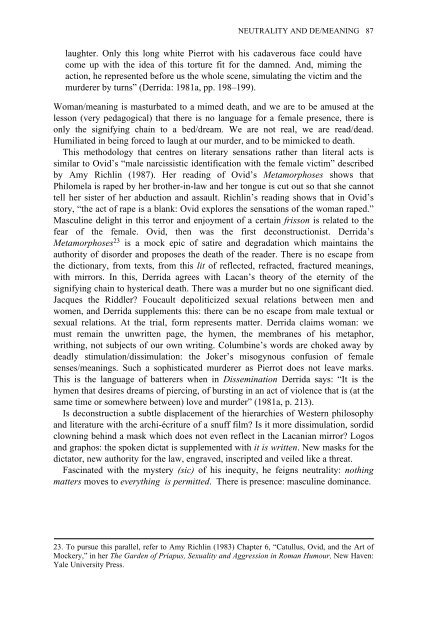Nothing Mat(t)ers: A Feminist Critique of Postmodernism
Nothing Mat(t)ers: A Feminist Critique of Postmodernism
Nothing Mat(t)ers: A Feminist Critique of Postmodernism
You also want an ePaper? Increase the reach of your titles
YUMPU automatically turns print PDFs into web optimized ePapers that Google loves.
NEUTRALITY AND DE/MEANING 87<br />
laughter. Only this long white Pierrot with his cadaverous face could have<br />
come up with the idea <strong>of</strong> this torture fit for the damned. And, miming the<br />
action, he represented before us the whole scene, simulating the victim and the<br />
murderer by turns” (Derrida: 1981a, pp. 198–199).<br />
Woman/meaning is masturbated to a mimed death, and we are to be amused at the<br />
lesson (very pedagogical) that there is no language for a female presence, there is<br />
only the signifying chain to a bed/dream. We are not real, we are read/dead.<br />
Humiliated in being forced to laugh at our murder, and to be mimicked to death.<br />
This methodology that centres on literary sensations rather than literal acts is<br />
similar to Ovid’s “male narcissistic identification with the female victim” described<br />
by Amy Richlin (1987). Her reading <strong>of</strong> Ovid’s Metamorphoses shows that<br />
Philomela is raped by her brother-in-law and her tongue is cut out so that she cannot<br />
tell her sister <strong>of</strong> her abduction and assault. Richlin’s reading shows that in Ovid’s<br />
story, “the act <strong>of</strong> rape is a blank: Ovid explores the sensations <strong>of</strong> the woman raped.”<br />
Masculine delight in this terror and enjoyment <strong>of</strong> a certain frisson is related to the<br />
fear <strong>of</strong> the female. Ovid, then was the first deconstructionist. Derrida’s<br />
Metamorphoses 23 is a mock epic <strong>of</strong> satire and degradation which maintains the<br />
authority <strong>of</strong> disorder and proposes the death <strong>of</strong> the reader. There is no escape from<br />
the dictionary, from texts, from this lit <strong>of</strong> reflected, refracted, fractured meanings,<br />
with mirrors. In this, Derrida agrees with Lacan’s theory <strong>of</strong> the eternity <strong>of</strong> the<br />
signifying chain to hysterical death. There was a murder but no one significant died.<br />
Jacques the Riddler Foucault depoliticized sexual relations between men and<br />
women, and Derrida supplements this: there can be no escape from male textual or<br />
sexual relations. At the trial, form represents matter. Derrida claims woman: we<br />
must remain the unwritten page, the hymen, the membranes <strong>of</strong> his metaphor,<br />
writhing, not subjects <strong>of</strong> our own writing. Columbine’s words are choked away by<br />
deadly stimulation/dissimulation: the Joker’s misogynous confusion <strong>of</strong> female<br />
senses/meanings. Such a sophisticated murderer as Pierrot does not leave marks.<br />
This is the language <strong>of</strong> batter<strong>ers</strong> when in Dissemination Derrida says: “It is the<br />
hymen that desires dreams <strong>of</strong> piercing, <strong>of</strong> bursting in an act <strong>of</strong> violence that is (at the<br />
same time or somewhere between) love and murder” (1981a, p. 213).<br />
Is deconstruction a subtle displacement <strong>of</strong> the hierarchies <strong>of</strong> Western philosophy<br />
and literature with the archi-écriture <strong>of</strong> a snuff film Is it more dissimulation, sordid<br />
clowning behind a mask which does not even reflect in the Lacanian mirror Logos<br />
and graphos: the spoken dictat is supplemented with it is written. New masks for the<br />
dictator, new authority for the law, engraved, inscripted and veiled like a threat.<br />
Fascinated with the mystery (sic) <strong>of</strong> his inequity, he feigns neutrality: nothing<br />
matt<strong>ers</strong> moves to everything is permitted. There is presence: masculine dominance.<br />
23. To pursue this parallel, refer to Amy Richlin (1983) Chapter 6, “Catullus, Ovid, and the Art <strong>of</strong><br />
Mockery,” in her The Garden <strong>of</strong> Priapus, Sexuality and Aggression in Roman Humour, New Haven:<br />
Yale Univ<strong>ers</strong>ity Press.

















